Contemporary Management: Case Study on Planning and Culture Topics
VerifiedAdded on 2023/06/04
|10
|2042
|303
Case Study
AI Summary
This assignment presents a case study focusing on contemporary management issues, specifically organizational culture and planning within a VUCA (volatile, uncertain, complex, and ambiguous) environment. It includes elevator pitches on organizational planning and shaping organizational culture, addressing questions about the relevance of planning and strategies for improving organizational culture. The case study further delves into decision-making dilemmas, such as hiring expatriates and managing existing workforce perceptions, using the example of Renate Schmidt's challenges. It also examines the case of Parivar, an IT company struggling with a strong, potentially detrimental organizational culture. The analysis identifies conflicting values, provides advice for addressing these conflicts, and suggests alternative organizational structures to foster better communication and employee engagement. The document emphasizes the importance of adaptability, cross-cultural awareness, and conflict resolution skills in contemporary management.
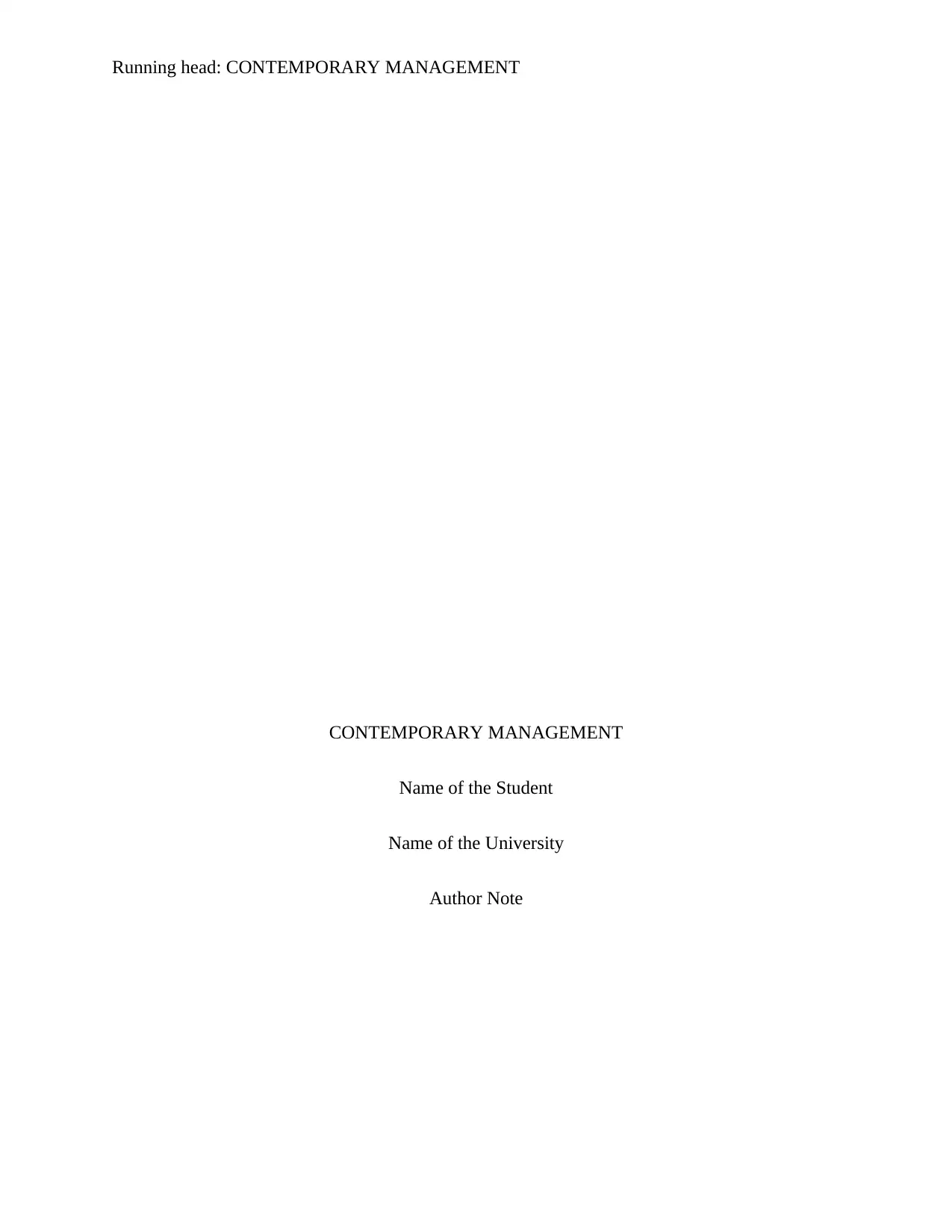
Running head: CONTEMPORARY MANAGEMENT
CONTEMPORARY MANAGEMENT
Name of the Student
Name of the University
Author Note
CONTEMPORARY MANAGEMENT
Name of the Student
Name of the University
Author Note
Paraphrase This Document
Need a fresh take? Get an instant paraphrase of this document with our AI Paraphraser

1CONTEMPORARY MANAGEMENT
Table of Contents
Part A: Elevator Pitches...................................................................................................................2
Elevator Pitch for Topic 6 (Organisational Planning).................................................................2
Elevator Pitch for Topic 8 (Shaping Organizational Culture).....................................................2
Case discussion Activity..................................................................................................................3
Case discussion activity for Topic 9:...........................................................................................3
Case discussion activity for Topic 10..........................................................................................5
References........................................................................................................................................8
Table of Contents
Part A: Elevator Pitches...................................................................................................................2
Elevator Pitch for Topic 6 (Organisational Planning).................................................................2
Elevator Pitch for Topic 8 (Shaping Organizational Culture).....................................................2
Case discussion Activity..................................................................................................................3
Case discussion activity for Topic 9:...........................................................................................3
Case discussion activity for Topic 10..........................................................................................5
References........................................................................................................................................8
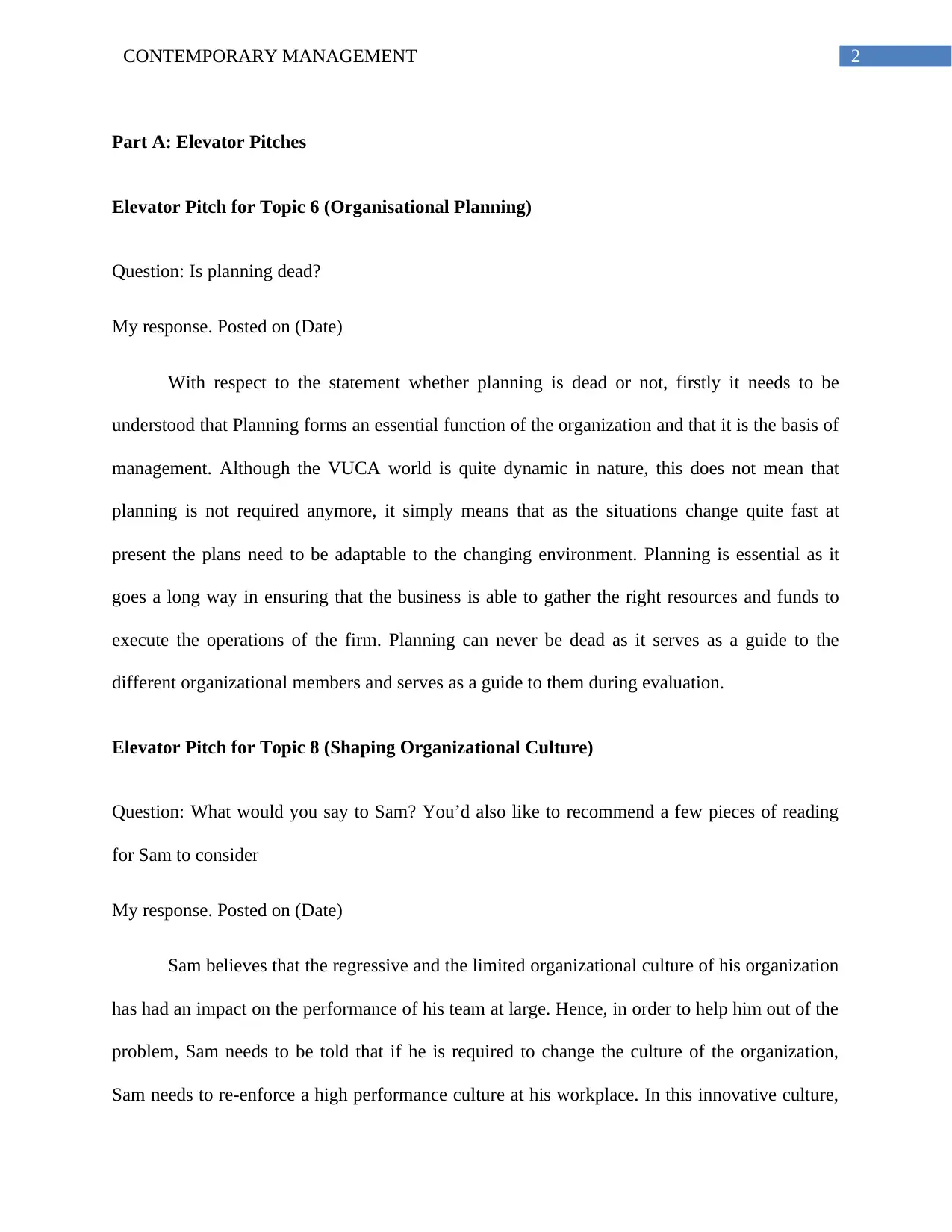
2CONTEMPORARY MANAGEMENT
Part A: Elevator Pitches
Elevator Pitch for Topic 6 (Organisational Planning)
Question: Is planning dead?
My response. Posted on (Date)
With respect to the statement whether planning is dead or not, firstly it needs to be
understood that Planning forms an essential function of the organization and that it is the basis of
management. Although the VUCA world is quite dynamic in nature, this does not mean that
planning is not required anymore, it simply means that as the situations change quite fast at
present the plans need to be adaptable to the changing environment. Planning is essential as it
goes a long way in ensuring that the business is able to gather the right resources and funds to
execute the operations of the firm. Planning can never be dead as it serves as a guide to the
different organizational members and serves as a guide to them during evaluation.
Elevator Pitch for Topic 8 (Shaping Organizational Culture)
Question: What would you say to Sam? You’d also like to recommend a few pieces of reading
for Sam to consider
My response. Posted on (Date)
Sam believes that the regressive and the limited organizational culture of his organization
has had an impact on the performance of his team at large. Hence, in order to help him out of the
problem, Sam needs to be told that if he is required to change the culture of the organization,
Sam needs to re-enforce a high performance culture at his workplace. In this innovative culture,
Part A: Elevator Pitches
Elevator Pitch for Topic 6 (Organisational Planning)
Question: Is planning dead?
My response. Posted on (Date)
With respect to the statement whether planning is dead or not, firstly it needs to be
understood that Planning forms an essential function of the organization and that it is the basis of
management. Although the VUCA world is quite dynamic in nature, this does not mean that
planning is not required anymore, it simply means that as the situations change quite fast at
present the plans need to be adaptable to the changing environment. Planning is essential as it
goes a long way in ensuring that the business is able to gather the right resources and funds to
execute the operations of the firm. Planning can never be dead as it serves as a guide to the
different organizational members and serves as a guide to them during evaluation.
Elevator Pitch for Topic 8 (Shaping Organizational Culture)
Question: What would you say to Sam? You’d also like to recommend a few pieces of reading
for Sam to consider
My response. Posted on (Date)
Sam believes that the regressive and the limited organizational culture of his organization
has had an impact on the performance of his team at large. Hence, in order to help him out of the
problem, Sam needs to be told that if he is required to change the culture of the organization,
Sam needs to re-enforce a high performance culture at his workplace. In this innovative culture,
⊘ This is a preview!⊘
Do you want full access?
Subscribe today to unlock all pages.

Trusted by 1+ million students worldwide

3CONTEMPORARY MANAGEMENT
Sam needs to engage into employee discussions as well as perceptions which shall then make
them feel valued and motivated. In lieu of this, the employee performance improves and
ultimately the team will perform considerably well and will have a life of its own. Hence,
parallel to the culture of the organization, Sam needs to establish a good high performing culture
so that his team performance improves.
The readings which have been suggested for Sam are given as follows:
https://www.strategy-business.com/article/10-Principles-of-Organizational-Culture?
gko=71d2f
https://hbr.org/2013/05/what-is-organizational-culture
https://www.managementstudyguide.com/importance-of-organization-culture.htm
Case discussion Activity
Case discussion activity for Topic 9:
The case 9 of the given coursework deals with the case of Renate Schmidt who is
currently in between a decision making procedure which makes her stuck between the hiring of a
new expatriate and the management of the current employees in the firm (McGregor & Doshi,
2015). The main dilemma arises in the case study in a case whereby the pay structure of the
expatriate is relatively high and thus bringing about doubts.
Answer to Question 1: The conflicting values present
Sam needs to engage into employee discussions as well as perceptions which shall then make
them feel valued and motivated. In lieu of this, the employee performance improves and
ultimately the team will perform considerably well and will have a life of its own. Hence,
parallel to the culture of the organization, Sam needs to establish a good high performing culture
so that his team performance improves.
The readings which have been suggested for Sam are given as follows:
https://www.strategy-business.com/article/10-Principles-of-Organizational-Culture?
gko=71d2f
https://hbr.org/2013/05/what-is-organizational-culture
https://www.managementstudyguide.com/importance-of-organization-culture.htm
Case discussion Activity
Case discussion activity for Topic 9:
The case 9 of the given coursework deals with the case of Renate Schmidt who is
currently in between a decision making procedure which makes her stuck between the hiring of a
new expatriate and the management of the current employees in the firm (McGregor & Doshi,
2015). The main dilemma arises in the case study in a case whereby the pay structure of the
expatriate is relatively high and thus bringing about doubts.
Answer to Question 1: The conflicting values present
Paraphrase This Document
Need a fresh take? Get an instant paraphrase of this document with our AI Paraphraser
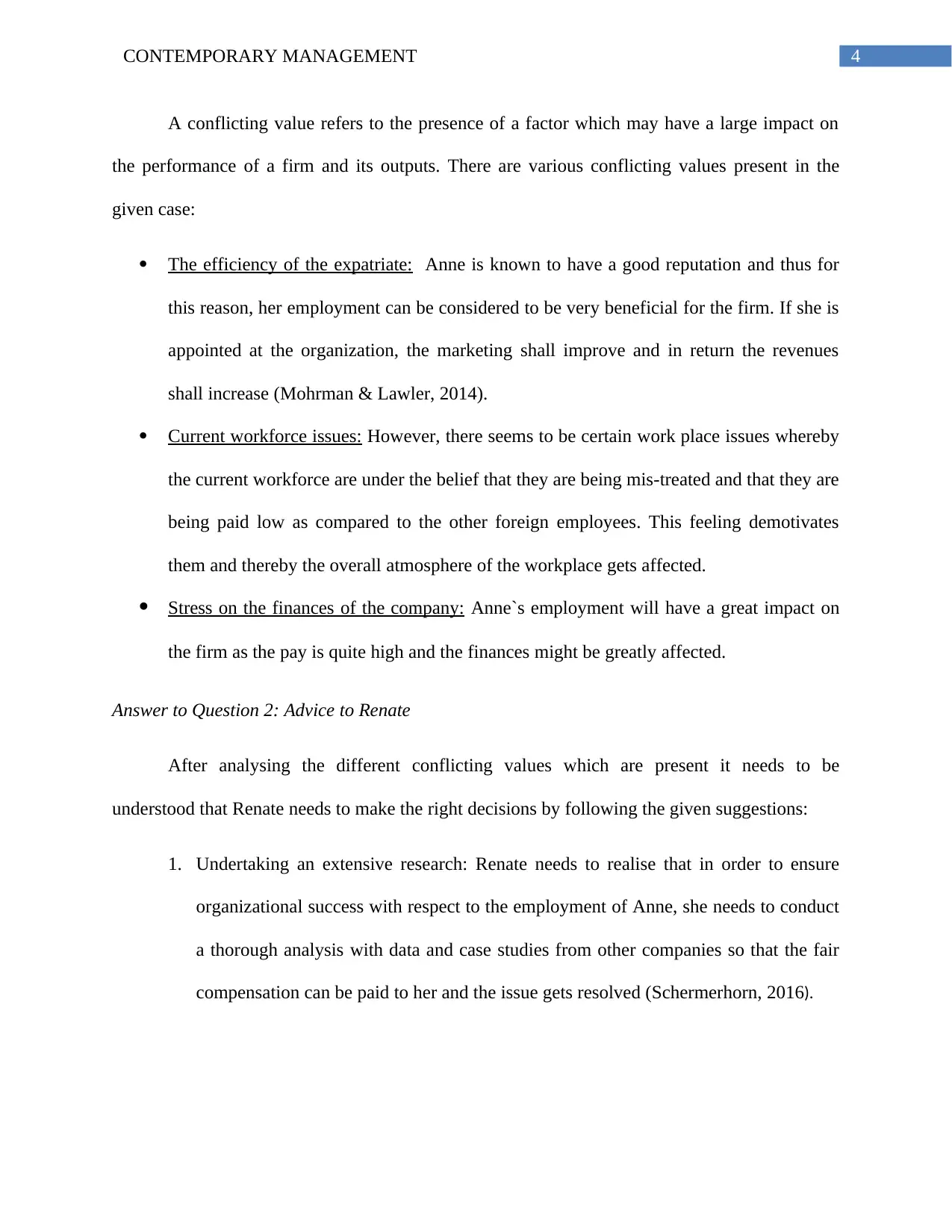
4CONTEMPORARY MANAGEMENT
A conflicting value refers to the presence of a factor which may have a large impact on
the performance of a firm and its outputs. There are various conflicting values present in the
given case:
The efficiency of the expatriate: Anne is known to have a good reputation and thus for
this reason, her employment can be considered to be very beneficial for the firm. If she is
appointed at the organization, the marketing shall improve and in return the revenues
shall increase (Mohrman & Lawler, 2014).
Current workforce issues: However, there seems to be certain work place issues whereby
the current workforce are under the belief that they are being mis-treated and that they are
being paid low as compared to the other foreign employees. This feeling demotivates
them and thereby the overall atmosphere of the workplace gets affected.
Stress on the finances of the company: Anne`s employment will have a great impact on
the firm as the pay is quite high and the finances might be greatly affected.
Answer to Question 2: Advice to Renate
After analysing the different conflicting values which are present it needs to be
understood that Renate needs to make the right decisions by following the given suggestions:
1. Undertaking an extensive research: Renate needs to realise that in order to ensure
organizational success with respect to the employment of Anne, she needs to conduct
a thorough analysis with data and case studies from other companies so that the fair
compensation can be paid to her and the issue gets resolved (Schermerhorn, 2016).
A conflicting value refers to the presence of a factor which may have a large impact on
the performance of a firm and its outputs. There are various conflicting values present in the
given case:
The efficiency of the expatriate: Anne is known to have a good reputation and thus for
this reason, her employment can be considered to be very beneficial for the firm. If she is
appointed at the organization, the marketing shall improve and in return the revenues
shall increase (Mohrman & Lawler, 2014).
Current workforce issues: However, there seems to be certain work place issues whereby
the current workforce are under the belief that they are being mis-treated and that they are
being paid low as compared to the other foreign employees. This feeling demotivates
them and thereby the overall atmosphere of the workplace gets affected.
Stress on the finances of the company: Anne`s employment will have a great impact on
the firm as the pay is quite high and the finances might be greatly affected.
Answer to Question 2: Advice to Renate
After analysing the different conflicting values which are present it needs to be
understood that Renate needs to make the right decisions by following the given suggestions:
1. Undertaking an extensive research: Renate needs to realise that in order to ensure
organizational success with respect to the employment of Anne, she needs to conduct
a thorough analysis with data and case studies from other companies so that the fair
compensation can be paid to her and the issue gets resolved (Schermerhorn, 2016).

5CONTEMPORARY MANAGEMENT
2. Conducting a cost benefit analysis: A cost benefit analysis will help in assessing the
effeciency of hiring Anne which will then help in the decision making whether her
employment will be beneficial to the firm or not.
3. Meeting with the CEO: Renate needs to arrange a meeting with the CEO so as to talk
about the implementation of a fair wage system for the current workforce.
Answer to Question 3- The crucial Management competencies of the VUCA World
Management competencies have greatly changed in the current VUCA world and for this
reason, the given competencies have become crucial to possess:
Decision making skills: A good manager is required to possess adequate decision
making skills.
International Legal knowledge: He needs to have related international legal knowledge.
Cross cultural awareness: The managers are required to possess cross cultural awareness
(Youtube.com. , 2018).
Conflict resolution skills: They need to have conflict resolution skills which shall then
assist them in solving problems in a firm (Kramar et al., 2014).
Case discussion activity for Topic 10
Case name: Can a strong culture be too strong?
My response to questions. Posted on (date):
` Can a strong culture be too strong? ` is a case which relates to the concern of an
organization named Parivar which is an Indian Information Technology company. They are
facing employment problems whereby a majority of their workforce have been leaving the firm
2. Conducting a cost benefit analysis: A cost benefit analysis will help in assessing the
effeciency of hiring Anne which will then help in the decision making whether her
employment will be beneficial to the firm or not.
3. Meeting with the CEO: Renate needs to arrange a meeting with the CEO so as to talk
about the implementation of a fair wage system for the current workforce.
Answer to Question 3- The crucial Management competencies of the VUCA World
Management competencies have greatly changed in the current VUCA world and for this
reason, the given competencies have become crucial to possess:
Decision making skills: A good manager is required to possess adequate decision
making skills.
International Legal knowledge: He needs to have related international legal knowledge.
Cross cultural awareness: The managers are required to possess cross cultural awareness
(Youtube.com. , 2018).
Conflict resolution skills: They need to have conflict resolution skills which shall then
assist them in solving problems in a firm (Kramar et al., 2014).
Case discussion activity for Topic 10
Case name: Can a strong culture be too strong?
My response to questions. Posted on (date):
` Can a strong culture be too strong? ` is a case which relates to the concern of an
organization named Parivar which is an Indian Information Technology company. They are
facing employment problems whereby a majority of their workforce have been leaving the firm
⊘ This is a preview!⊘
Do you want full access?
Subscribe today to unlock all pages.

Trusted by 1+ million students worldwide
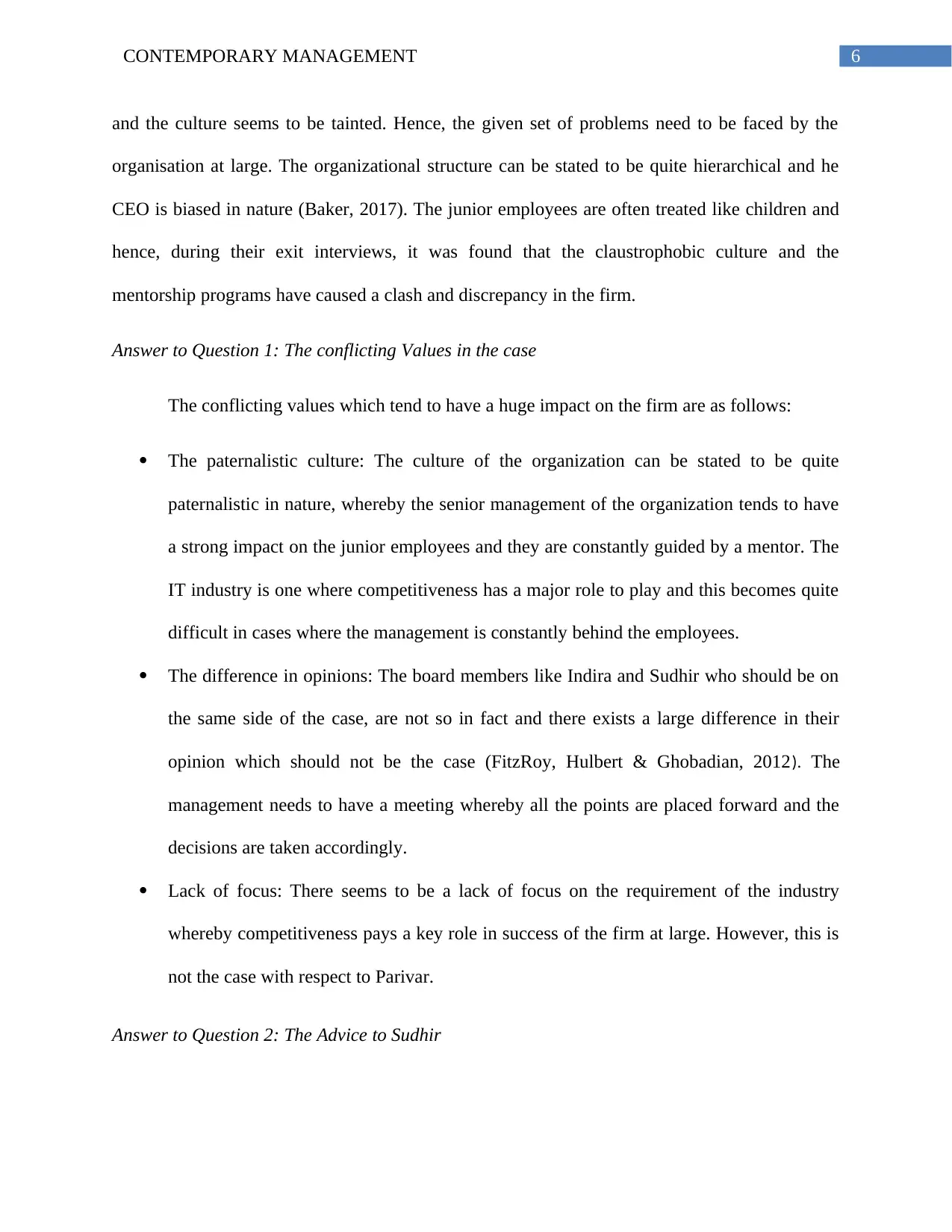
6CONTEMPORARY MANAGEMENT
and the culture seems to be tainted. Hence, the given set of problems need to be faced by the
organisation at large. The organizational structure can be stated to be quite hierarchical and he
CEO is biased in nature (Baker, 2017). The junior employees are often treated like children and
hence, during their exit interviews, it was found that the claustrophobic culture and the
mentorship programs have caused a clash and discrepancy in the firm.
Answer to Question 1: The conflicting Values in the case
The conflicting values which tend to have a huge impact on the firm are as follows:
The paternalistic culture: The culture of the organization can be stated to be quite
paternalistic in nature, whereby the senior management of the organization tends to have
a strong impact on the junior employees and they are constantly guided by a mentor. The
IT industry is one where competitiveness has a major role to play and this becomes quite
difficult in cases where the management is constantly behind the employees.
The difference in opinions: The board members like Indira and Sudhir who should be on
the same side of the case, are not so in fact and there exists a large difference in their
opinion which should not be the case (FitzRoy, Hulbert & Ghobadian, 2012). The
management needs to have a meeting whereby all the points are placed forward and the
decisions are taken accordingly.
Lack of focus: There seems to be a lack of focus on the requirement of the industry
whereby competitiveness pays a key role in success of the firm at large. However, this is
not the case with respect to Parivar.
Answer to Question 2: The Advice to Sudhir
and the culture seems to be tainted. Hence, the given set of problems need to be faced by the
organisation at large. The organizational structure can be stated to be quite hierarchical and he
CEO is biased in nature (Baker, 2017). The junior employees are often treated like children and
hence, during their exit interviews, it was found that the claustrophobic culture and the
mentorship programs have caused a clash and discrepancy in the firm.
Answer to Question 1: The conflicting Values in the case
The conflicting values which tend to have a huge impact on the firm are as follows:
The paternalistic culture: The culture of the organization can be stated to be quite
paternalistic in nature, whereby the senior management of the organization tends to have
a strong impact on the junior employees and they are constantly guided by a mentor. The
IT industry is one where competitiveness has a major role to play and this becomes quite
difficult in cases where the management is constantly behind the employees.
The difference in opinions: The board members like Indira and Sudhir who should be on
the same side of the case, are not so in fact and there exists a large difference in their
opinion which should not be the case (FitzRoy, Hulbert & Ghobadian, 2012). The
management needs to have a meeting whereby all the points are placed forward and the
decisions are taken accordingly.
Lack of focus: There seems to be a lack of focus on the requirement of the industry
whereby competitiveness pays a key role in success of the firm at large. However, this is
not the case with respect to Parivar.
Answer to Question 2: The Advice to Sudhir
Paraphrase This Document
Need a fresh take? Get an instant paraphrase of this document with our AI Paraphraser

7CONTEMPORARY MANAGEMENT
After the analysis of the Conflicting values and the related dilemmas as present in the
given case study, the following advice can be given to Sudhir:
Slow it down with the culture: Sudhir needs to understand that the love culture of the
organization which is generally proclaimed by him is not working out and that despite his
`consistent` efforts the turnover rate of the firm has been considerably high (de Waal, 2016).
Hence, with respect to this, the firm needs to ensure that it takes in measures to try and undergo a
cultural change for the organization and ensure success.
Encouraging the people support initiative: The people support program can be stated to
be a good initiative on the side of Parivar and as the turnover rate of the firm has been as high as
35% it needs to be understood that this program needs to be undertaken with a full swing.
Take decisions with respect to improving the Hygiene program: The salary structure of
Parivar needs to be improved considerably improved as it is not just the culture which motivates
the people but also the pay and compensation structure.
Answer to Question 3: Suggested Structure
It can be clearly understood that the organization is in a need of a good structure and with
respect to this, it is suggested that instead of a hierarchical structure like that of Parivar at
present, it needs to adopt a flat structure which will then ensure that the communication at the
workplace is more efficient in nature and that no biasness prevails. This also encourages
employee engagement from the side of the employees and they feel valued. Moreover, the
culture also needs to undergo a change which will beneficial in the long run.
After the analysis of the Conflicting values and the related dilemmas as present in the
given case study, the following advice can be given to Sudhir:
Slow it down with the culture: Sudhir needs to understand that the love culture of the
organization which is generally proclaimed by him is not working out and that despite his
`consistent` efforts the turnover rate of the firm has been considerably high (de Waal, 2016).
Hence, with respect to this, the firm needs to ensure that it takes in measures to try and undergo a
cultural change for the organization and ensure success.
Encouraging the people support initiative: The people support program can be stated to
be a good initiative on the side of Parivar and as the turnover rate of the firm has been as high as
35% it needs to be understood that this program needs to be undertaken with a full swing.
Take decisions with respect to improving the Hygiene program: The salary structure of
Parivar needs to be improved considerably improved as it is not just the culture which motivates
the people but also the pay and compensation structure.
Answer to Question 3: Suggested Structure
It can be clearly understood that the organization is in a need of a good structure and with
respect to this, it is suggested that instead of a hierarchical structure like that of Parivar at
present, it needs to adopt a flat structure which will then ensure that the communication at the
workplace is more efficient in nature and that no biasness prevails. This also encourages
employee engagement from the side of the employees and they feel valued. Moreover, the
culture also needs to undergo a change which will beneficial in the long run.
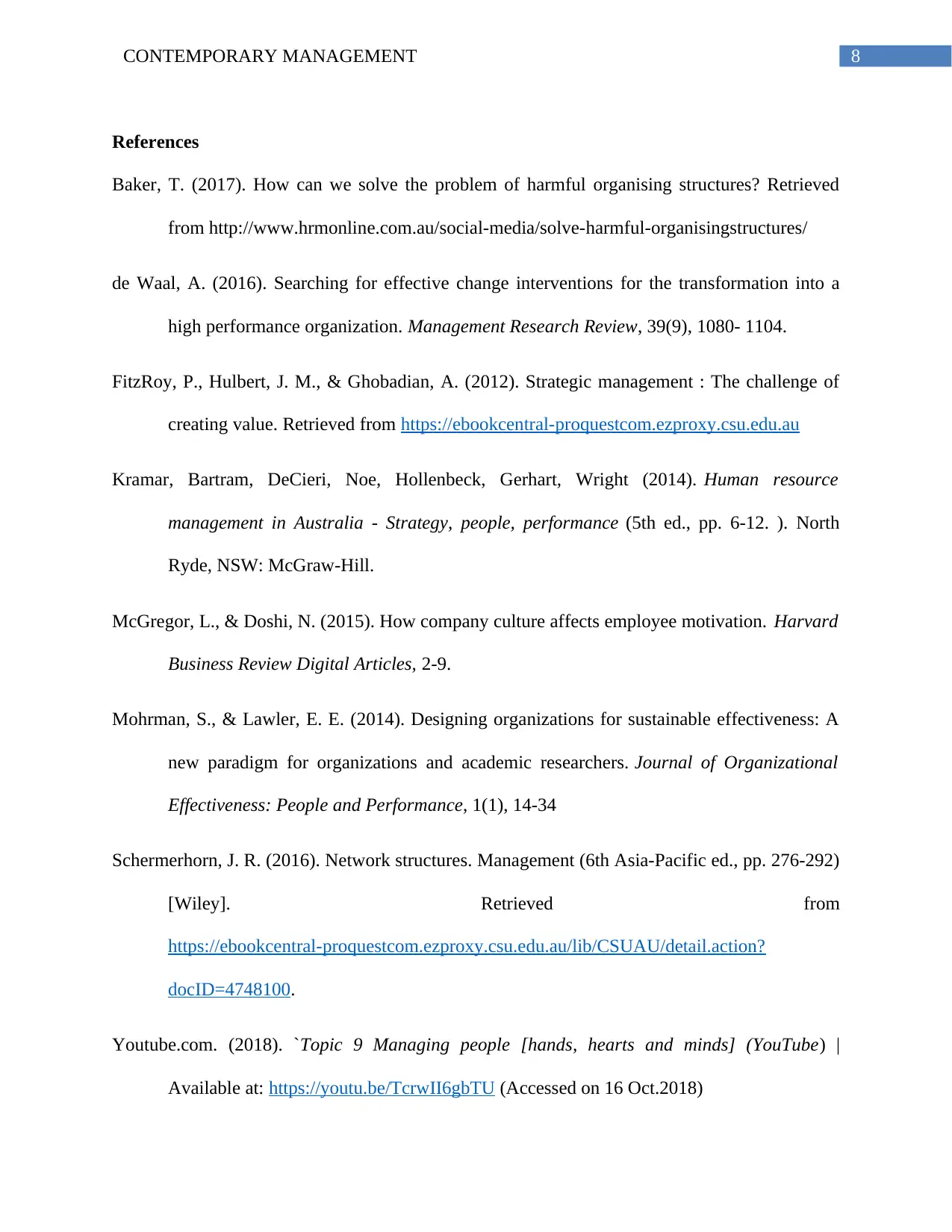
8CONTEMPORARY MANAGEMENT
References
Baker, T. (2017). How can we solve the problem of harmful organising structures? Retrieved
from http://www.hrmonline.com.au/social-media/solve-harmful-organisingstructures/
de Waal, A. (2016). Searching for effective change interventions for the transformation into a
high performance organization. Management Research Review, 39(9), 1080- 1104.
FitzRoy, P., Hulbert, J. M., & Ghobadian, A. (2012). Strategic management : The challenge of
creating value. Retrieved from https://ebookcentral-proquestcom.ezproxy.csu.edu.au
Kramar, Bartram, DeCieri, Noe, Hollenbeck, Gerhart, Wright (2014). Human resource
management in Australia - Strategy, people, performance (5th ed., pp. 6-12. ). North
Ryde, NSW: McGraw-Hill.
McGregor, L., & Doshi, N. (2015). How company culture affects employee motivation. Harvard
Business Review Digital Articles, 2-9.
Mohrman, S., & Lawler, E. E. (2014). Designing organizations for sustainable effectiveness: A
new paradigm for organizations and academic researchers. Journal of Organizational
Effectiveness: People and Performance, 1(1), 14-34
Schermerhorn, J. R. (2016). Network structures. Management (6th Asia-Pacific ed., pp. 276-292)
[Wiley]. Retrieved from
https://ebookcentral-proquestcom.ezproxy.csu.edu.au/lib/CSUAU/detail.action?
docID=4748100.
Youtube.com. (2018). `Topic 9 Managing people [hands, hearts and minds] (YouTube) |
Available at: https://youtu.be/TcrwII6gbTU (Accessed on 16 Oct.2018)
References
Baker, T. (2017). How can we solve the problem of harmful organising structures? Retrieved
from http://www.hrmonline.com.au/social-media/solve-harmful-organisingstructures/
de Waal, A. (2016). Searching for effective change interventions for the transformation into a
high performance organization. Management Research Review, 39(9), 1080- 1104.
FitzRoy, P., Hulbert, J. M., & Ghobadian, A. (2012). Strategic management : The challenge of
creating value. Retrieved from https://ebookcentral-proquestcom.ezproxy.csu.edu.au
Kramar, Bartram, DeCieri, Noe, Hollenbeck, Gerhart, Wright (2014). Human resource
management in Australia - Strategy, people, performance (5th ed., pp. 6-12. ). North
Ryde, NSW: McGraw-Hill.
McGregor, L., & Doshi, N. (2015). How company culture affects employee motivation. Harvard
Business Review Digital Articles, 2-9.
Mohrman, S., & Lawler, E. E. (2014). Designing organizations for sustainable effectiveness: A
new paradigm for organizations and academic researchers. Journal of Organizational
Effectiveness: People and Performance, 1(1), 14-34
Schermerhorn, J. R. (2016). Network structures. Management (6th Asia-Pacific ed., pp. 276-292)
[Wiley]. Retrieved from
https://ebookcentral-proquestcom.ezproxy.csu.edu.au/lib/CSUAU/detail.action?
docID=4748100.
Youtube.com. (2018). `Topic 9 Managing people [hands, hearts and minds] (YouTube) |
Available at: https://youtu.be/TcrwII6gbTU (Accessed on 16 Oct.2018)
⊘ This is a preview!⊘
Do you want full access?
Subscribe today to unlock all pages.

Trusted by 1+ million students worldwide

9CONTEMPORARY MANAGEMENT
1 out of 10
Related Documents
Your All-in-One AI-Powered Toolkit for Academic Success.
+13062052269
info@desklib.com
Available 24*7 on WhatsApp / Email
![[object Object]](/_next/static/media/star-bottom.7253800d.svg)
Unlock your academic potential
Copyright © 2020–2025 A2Z Services. All Rights Reserved. Developed and managed by ZUCOL.





